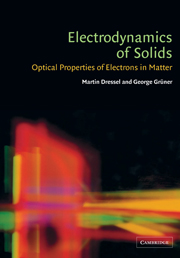12 - Metals
Published online by Cambridge University Press: 20 May 2010
Summary
Optical investigations have contributed much to our current understanding of the electronic state of conductors. Early studies have focused on the behavior of simple metals, on the single-particle and collective responses of the free-electron gas, and on Fermi-surface phenomena. Here the relevant energy scales are the single-particle bandwidth W, the plasma frequency ωp, and the single-particle scattering rate 1/τ, all lying in the spectral range of conventional optics. Consequently, when simple metals are investigated standard optical studies are of primary importance. Recent focus areas include the influence of electron–electron and electron–phonon interactions on the electron states, the possibility of non-Fermi-liquid states, the highly anisotropic, in particular two-dimensional, electron gas, together with disorder driven metal–insulator transition. Here, because of renormalization effects and low carrier density, and also often because of close proximity to a phase transition, the energy scales are – as a rule – significantly smaller than the single-particle energies. Consequently the exploration of low energy electrodynamics, i.e. the response in the millimeter wave spectral range or below, is of central importance.
Simple metals
In a broad range of metals – most notably alkaline metals, but also metals like aluminum – the kinetic energy of the electrons is large, significantly larger then the potential energy created by the periodic underlying lattice. Also, because of screening the strength of electron–electron and electron–phonon interactions is small; they can for all practical purposes be neglected.
- Type
- Chapter
- Information
- Electrodynamics of SolidsOptical Properties of Electrons in Matter, pp. 301 - 338Publisher: Cambridge University PressPrint publication year: 2002
- 1
- Cited by



